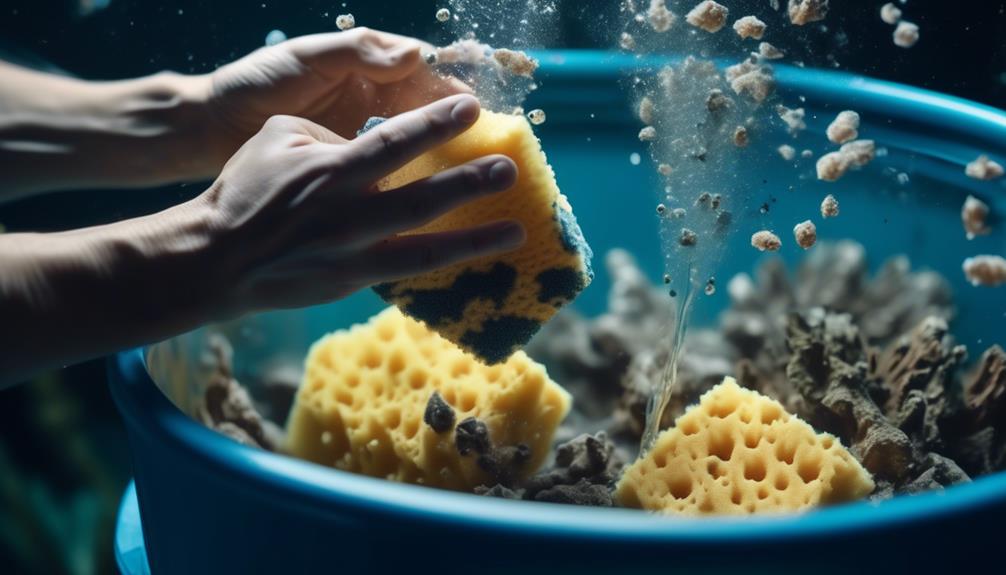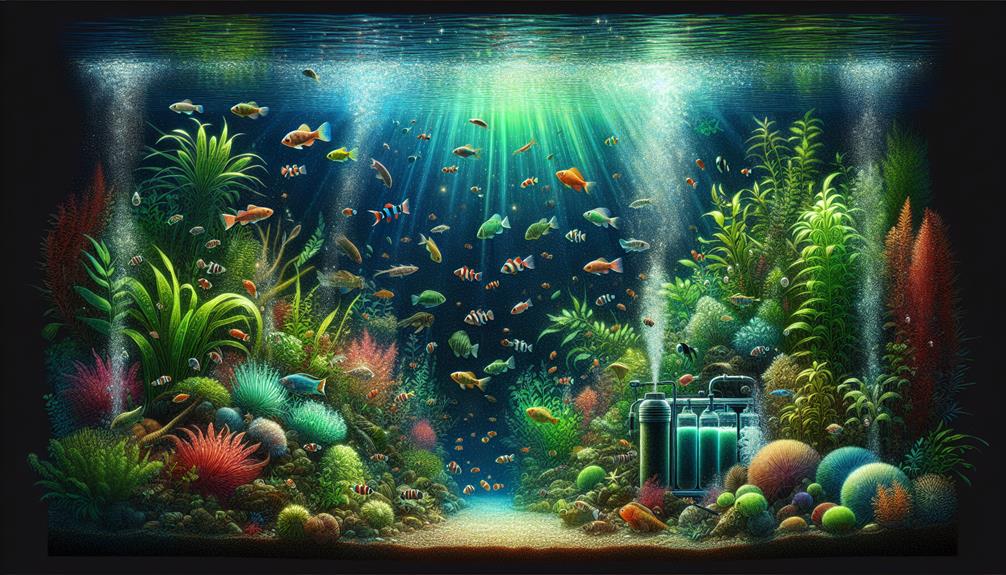Are you tired of wasting time and money on complicated and ineffective fish tank filtration systems? Look no further than the Aquarium Co-Op Sponge Filter, a true game-changer in the world of aquarium maintenance.
With its innovative design and impressive functionality, this filter is revolutionizing the way fishkeepers approach filtration.
So, what exactly sets this filter apart from the rest? How does it work? And most importantly, what benefits can it offer you and your aquatic pets?
Get ready to discover a whole new level of efficiency and simplicity as we dive into the world of Aquarium Co-Op Sponge Filters.
Key Takeaways
- Sponge filters are popular for their simplicity and effectiveness in providing both mechanical and biological filtration.
- They are easy to clean and maintain, with different types available for different tank sizes and needs.
- The Aquarium Co-Op sponge filter offers an improved design for efficient filtration, optimal surface area for bacterial colonization, and benefits for planted tanks.
- Using an air stone with a sponge filter can enhance oxygen levels and water circulation, but it may increase noise levels and agitation for some fish species.
Basics of Sponge Filters
Sponge filters are a popular choice for fish tank filtration due to their simplicity and effectiveness. They offer several advantages over other types of filters.
One advantage is that sponge filters provide both mechanical and biological filtration. The sponge acts as a mechanical filter, trapping debris and waste particles, while also providing a surface for beneficial bacteria to grow and break down harmful substances.
Another advantage is that sponge filters are easy to maintain. They can be easily cleaned by rinsing the sponge in tank water, ensuring that the beneficial bacteria remain intact.
Additionally, there are different types of sponge filters available, such as single sponge filters and double sponge filters, allowing you to choose the one that best suits your tank size and needs.
Comparing Aquarium Co-Op Sponge Filters
When comparing different options for fish tank filtration, it's important to consider the features and improvements of the Aquarium Co-Op sponge filter. Here are three key aspects that set it apart:
- Improved Design: The Aquarium Co-Op sponge filter incorporates advancements in sponge filter design, ensuring efficient biological and mechanical filtration. It provides a large surface area for beneficial bacteria to thrive, resulting in excellent water quality.
- Ideal Surface Area and Water Flow: The Co-Op sponge filter is designed to provide optimal surface area for bacterial colonization. This promotes the breakdown of harmful toxins and helps maintain a healthy environment for your fish. Additionally, the water flow is carefully calibrated to prevent clogging and ensure effective filtration.
- Benefits for Planted Tanks: Sponge filters are particularly beneficial for planted tanks as they provide gentle and consistent water movement, preventing stagnant areas and promoting nutrient distribution. The Aquarium Co-Op sponge filter is specifically designed to cater to the needs of planted tanks, helping to create a thriving and balanced aquatic ecosystem.
Air Stones and Sponge Filters

Using an air stone with a sponge filter is a topic of debate among aquarium enthusiasts.
There are advantages to using an air stone with a sponge filter. Firstly, the air stone helps to increase the oxygen levels in the water, creating a healthier environment for your fish. It also enhances water circulation, leading to better filtration and preventing dead spots in the tank. Additionally, the air stone creates a beautiful display of bubbles, adding visual appeal to your aquarium.
However, there are potential drawbacks to using an air stone with a sponge filter. It can increase noise levels, especially if the air pump is located near the tank. The bubbles may also cause excessive agitation for some fish species.
Ultimately, the decision to use an air stone with a sponge filter depends on your specific tank setup and the needs of your fish.
Setting Up a Sponge Filter
To properly set up a sponge filter, it's important to follow a few simple steps:
- Assemble the sponge filter: Start by attaching the airline tubing to the air pump and then connect the other end to the sponge filter. Ensure that all connections are secure.
- Adjust the height: Depending on the depth of your tank, you may need to adjust the height of the sponge filter. Simply slide the tube up or down until the sponge is positioned just above the substrate.
- Troubleshoot bubbles: If you notice bubbles coming out of the side of the sponge, it may be due to excess air flow. Try reducing the air pump's output or adding a flow control valve to regulate the air pressure.
Maintenance and Cleaning of Sponge Filters

Regular maintenance and cleaning of your sponge filter is essential to ensure optimal performance and a healthy aquarium environment. To keep your sponge filter running smoothly, it's recommended to choose a sponge filter with a sturdy construction and high-quality materials. Look for features such as a durable sponge, adjustable flow rate, and a reliable air pump.
When it comes to cleaning your sponge filter, it's important to avoid using tap water as it can contain chlorine or other chemicals harmful to your fish. Instead, rinse the sponge in aquarium water during water changes to remove debris and buildup.
If you encounter any issues with your sponge filter, such as reduced water flow or excessive bubbles, try adjusting the air pump or cleaning the sponge more thoroughly. By regularly maintaining and cleaning your sponge filter, you can ensure that it continues to provide efficient filtration for your aquarium.
Frequently Asked Questions
Can a Sponge Filter Be Used as the Sole Filtration System in a Fish Tank?
Yes, a sponge filter can be used as the sole filtration system in a fish tank. It offers benefits like biological filtration, gentle water flow, and affordability. Compared to traditional filters, sponge filters are low maintenance and provide a safe environment for your fish.
Can a Sponge Filter Be Used in a Saltwater Aquarium?
Yes, a sponge filter can be used in a saltwater aquarium. It offers many benefits, such as biological filtration and gentle water flow. The advantages of using a sponge filter include providing a safe environment for delicate marine life.
How Often Should a Sponge Filter Be Cleaned?
You might be wondering how often you should clean your sponge filter. Well, cleaning it regularly will ensure optimal performance and keep your fish tank clean and healthy.
Can a Sponge Filter Be Used in a Betta Fish Tank?
Using a sponge filter in a betta fish tank has pros and cons. It provides biological filtration and gentle water flow, but may not be suitable for heavily stocked tanks. Regular maintenance and monitoring water parameters are key for a healthy environment.
What Should I Do if My Sponge Filter Becomes Clogged?
If your sponge filter becomes clogged, don't worry! Just squeeze and rinse it gently in aquarium water. Avoid using tap water to preserve beneficial bacteria. Regular sponge filter maintenance prevents clogs and keeps your tank clean.
Conclusion
In conclusion, the Aquarium Co-Op Sponge Filter is like a loyal friend that simplifies your aquarium maintenance and creates a healthier environment for your fish.
Just like a trustworthy companion, this innovative filter revolutionizes fish tank filtration by providing simplicity, effectiveness, and improved water circulation.
Say goodbye to complicated and inefficient filtration systems and embrace the world of Aquarium Co-Op Sponge Filters for a stress-free and thriving aquarium experience.

